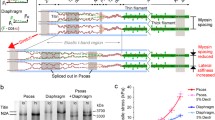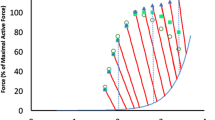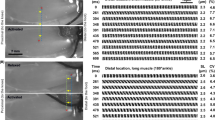Abstract
Relations between sarcomere length (SL) and force (F) were studied in ten fiber bundles (six to twenty fibers) from rat extensor digitorum muscles. A bundle (60 µm by 200–300 µm) was mounted in a glass covered perfusion chamber containing modified Krebs Henseleit buffer at 25°C, oxygenated with 95% O2, 5% CO2 and pancuronium bromide (8 mg/1). F (Disa 51E 01 transducer) and SL (laser diffraction and light microscopy) were measured; the latter could be controlled by a servomotor system. 200–500 ms tetanie stimulus trains were applied via platinum electrodes parallel to the muscle with 20% above maximal intensity, 160 Hz frequency and 1 ms duration of pulses. Tetani were at 2 min intervals. F attained a steady value 100 ms after the start of the tetanus at 2.0–2.5 pm SL and 350 ms at 3.5 µm SL.
Active force, measured during tetani in which sarcomere length was held constant, was maximal between SL = 2.15 µm and 2.65 µm and declined in linear fashion with SL to zero at SL = 3.90 µm. Active force at SL = 2.00 µm was 95% of maximal force. Passive force was manifest above SL = 3.10 µm and was 10% of maximal force at 3.80 µm.
Eight similar bundles were processed conventionally for electron microscopy (Philips EM 201A) while SL was measured during the processing steps. Measurements were made from micrographs of longitudinal sections. SL measured from the micrographs were consistent with the observed shrinkage (5%). Actin periodicity was 41.5 ± 0.19 nm; twenty-seven periods per actin filament were found. Filament lengths were corrected for an assumed actin periodicity of 39 nm. Actin length was 1.13 ± 0.013 pm; myosin length was 1.53 ± 0.015 µm. Bare zone was 0.17 µm ± 0.01 µm.
These filament lengths would give optimum overlap at SL between 2.26 and 2.43 µm and a linear decrease to zero with increasing SL from 2.43 µm to 3.79 µm. Actual force was consistently higher than predicted by overlap and force was maintained to both the left and the right of the predicted plateau.
Access this chapter
Tax calculation will be finalised at checkout
Purchases are for personal use only
Preview
Unable to display preview. Download preview PDF.
Similar content being viewed by others
References
Buller, A.J., Lewis, D.M. (1965). The rate of tension development in isometric tetanic contrac-tions of mammalian fast and slow skeletal muscle. J. Physiol. 176: 337–354
Close, R.I. (1972). Dynamic properties of mammalian skeletal muscle. Physiol. Rev. 52: 129–197
Craig, R., Offer, G. (1976). Axial arrangement of cross bridges in thick filaments of vertebrate skeletal muscle. J. Mol. Biol. 102: 325–332
Edman, K.A.P. (1980). The role of non-uniform sarcomere behaviour during relaxation of striated muscle. Eur. Heart J. l/suppl A: 49–57
Fabiato, A. and Fabiato, F. (1978). Myofilament-generated tension oscillations during partial calcium activation and activation dependence of the sarcomere length tension relation of skinned cardiac cells. J. Gen. Physiol. 72: 667–669
Gordon, A.M., Huxley, A.F., Julian, F.J. (1966). Tension development in highly stretched vertebrate muscle fibers. J. Physiol. 184: 143–169
Heuningen, R., Rijnsburger, W.H., ter Keurs, H.E.D.J. (1982). Sarcomere length control in striated muscle. Am. J. Physiol. 242: H411 - H420
Huxley, H.E. (1973). Structural changes in the actin-and myosin-containing filaments during contraction. Cold Spring Harbor Symp. Quant. Biol. 37: 361–377.
Huxley, H.E., Brown, W. (1967). The low angle X-ray diagram of vertebrate striated muscle and its behavior during contraction and rigor. J. Mol. Biol. 30: 383–434.
Keurs, H.E.D.J., Iwazumi, T., Pollack, G.H. (1978). The sarcomere length-tension relation in skeletal muscle. J. Gen. Physiol. 72: 565–592.
Keurs, H.E.D.J., Elzinga G. (1981). The sarcomere length-force relation of frog muscle; effects of sarcomere motion and species. VII Intern. Biophys. Congress and I II Pan-Am. Biochem. Congress (in the press)
McCarter, R., Radicke, D., Yu, B.P. (1977). A model preparation for studying fast mammalian skeletal muscles. Proc. Soc. Exp. Biel. and Med. 156: 40–45 (39871)
Page, S.G., Huxley, H.E. (1963). Filament lengths in striated muscle. J. Cell. Biol. 19: 369–391
Page, S.G. (1974). Measurements of structural parameters in cardiac muscle. In: The Phy-siological Basis of Starling’s Law of the Heart Ciba Symp. 24, Elsevier Excerpta Medica Ned North-Holland, Adam, London, New York
Rack, P.H.M., Westbury, D.R. (1965). The effects of length and stimulus rate on tension in the isometric cat soleus muscle. J. Physiol. 204: 443–460
Vibert, P.J., Hazelgrove, C.J., Lowy, J. (1972). Structural changes in actin containing filaments of muscle. J. Mol. Biol. 71: 757–767
Walker, S.M., Schrodt, G.R. (1973). Segment lengths and thin filament periods in skeletal muscle fibers of the rhesus monkey and the human. Anat. Records 178: 63–82
Wray, J.S., Holmes, K.C. (1981). X-ray diffraction studies of muscle. Ann. Rev. Physiol. 43: 553–565
Author information
Authors and Affiliations
Editor information
Editors and Affiliations
Rights and permissions
Copyright information
© 1984 Plenum Press, New York
About this chapter
Cite this chapter
ter Keurs, H.E.D.J., Luff, A.R., Luff, S.E. (1984). Force — Sarcomere-Length Relation and Filament Length in Rat Extensor Digitorum Muscle. In: Pollack, G.H., Sugi, H. (eds) Contractile Mechanisms in Muscle. Advances in Experimental Medicine and Biology, vol 37. Springer, Boston, MA. https://doi.org/10.1007/978-1-4684-4703-3_44
Download citation
DOI: https://doi.org/10.1007/978-1-4684-4703-3_44
Publisher Name: Springer, Boston, MA
Print ISBN: 978-1-4684-4705-7
Online ISBN: 978-1-4684-4703-3
eBook Packages: Springer Book Archive




